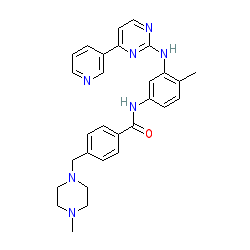|
Synonyms: CGP 57148 | Gleevec® | Glivec® | STI571
imatinib is an approved drug (FDA & EMA (2001))
Compound class:
Synthetic organic
Comment: Imatinib is a Type-2 kinase inhibitor. Its main inhibitory activity is against ABL kinase, but it has significant action at secondary targets including platelet-derived growth factor receptor (PDGFR) and stem cell growth factor receptor (KIT).
Coronavirus: imatinib is reported to block Spike protein-induced SARS-CoV and MERS-CoV fusion in vitro [8], potentially by blocking Abl2 at the endosomal membrane and disrupting the actin dynamics that are required for virus-host fusion [2]. It will be informative to determine if this holds true for SARS-CoV-2, and whether re-purposing of imatinib and/or newer Abl kinase inhibitors (dasatinib, bosutinib, ponatinib, nilotinib) could be a viable strategy against COVID-19. This approach would likely to be most effective during the early stage of infection. Ligand Activity Visualisation ChartsThese are box plot that provide a unique visualisation, summarising all the activity data for a ligand taken from ChEMBL and GtoPdb across multiple targets and species. Click on a plot to see the median, interquartile range, low and high data points. A value of zero indicates that no data are available. A separate chart is created for each target, and where possible the algorithm tries to merge ChEMBL and GtoPdb targets by matching them on name and UniProt accession, for each available species. However, please note that inconsistency in naming of targets may lead to data for the same target being reported across multiple charts. ✖
View more information in the IUPHAR Pharmacology Education Project: imatinib |
|
|||||||||||||||||||||||||||||||||||
| No information available. |
Summary of Clinical Use  |
| Used in the treatment of multiple cancers including chronic myelogenous leukemia and gastrointestinal stromal tumours (GIST). Adjuvant imatinib is recommended for KIT-mutated GISTs. The clinically administered form is the Imatinib mesilate (mesylate) salt (PubChem CID 123596). Generic imatinib mesylate tablets were approved by the US FDA in December 2015, as therapeutic equivalents of Novartis' original Gleevec. |
External links  |
|
For extended ADME data see the following: Electronic Medicines Compendium (eMC) Drugs.com European Medicines Agency (EMA) |









